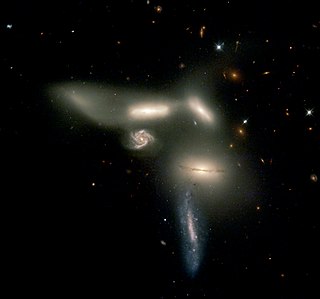
Seyfert's Sextet is a group of galaxies about 190 million light-years away in the constellation Serpens. The group appears to contain six members, but one of the galaxies, NGC 6027d, is a background object and another "galaxy," NGC 6027e, is actually a part of the tail from galaxy NGC 6027. The gravitational interaction among these galaxies should continue for hundreds of millions of years. Ultimately, the galaxies will merge to form a single giant elliptical galaxy.
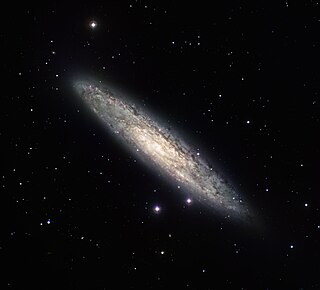
The Sculptor Galaxy is an intermediate spiral galaxy in the constellation Sculptor. The Sculptor Galaxy is a starburst galaxy, which means that it is currently undergoing a period of intense star formation.

NGC 4676, or the Mice Galaxies, are two spiral galaxies in the constellation Coma Berenices. About 290 million light-years distant, they have begun the process of colliding and merging. Their "mice" name refers to the long tails produced by tidal action—the relative difference between gravitational pulls on the near and far parts of each galaxy—known here as a galactic tide. It is a possibility that both galaxies, which are members of the Coma Cluster, have experienced collision, and will continue colliding until they coalesce.

Interacting galaxies are galaxies whose gravitational fields result in a disturbance of one another. An example of a minor interaction is a satellite galaxy disturbing the primary galaxy's spiral arms. An example of a major interaction is a galactic collision, which may lead to a galaxy merger.
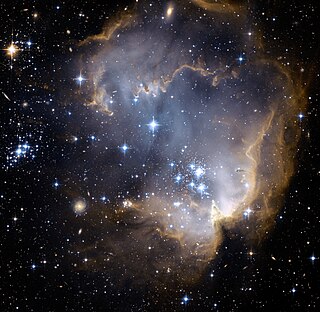
NGC 602 is a young, bright open cluster of stars located in the Small Magellanic Cloud (SMC), a satellite galaxy to the Milky Way. It is embedded in a nebula known as N90.
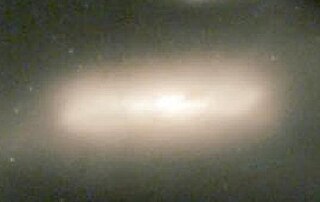
NGC 6027 is a lenticular galaxy discovered by Édouard Stephan in 1882 that is the brightest member of Seyfert's Sextet, a compact group of galaxies.
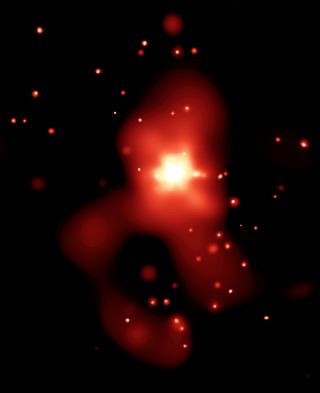
NGC 4261 is an elliptical galaxy located around 100 million light-years away in the constellation Virgo. It was discovered April 13, 1784 by the German-born astronomer William Herschel. The galaxy is a member of its own somewhat meager galaxy group known as the NGC 4261 group, which is part of the Virgo Cluster.
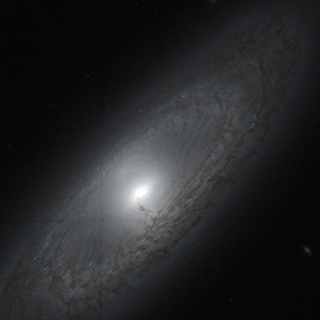
NGC 4448 is a barred spiral galaxy with a prominent inner ring structure in the constellation Coma Berenices.
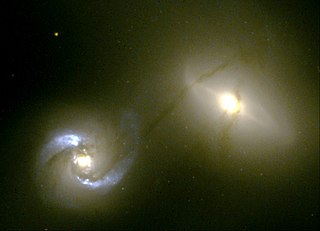
NGC 1410 is a peculiar lenticular galaxy in the constellation Taurus. It was discovered on January 17, 1855, by English astronomer R. J. Mitchell. NGC 1410 is located in close proximity to the larger lenticular galaxy NGC 1409, and the two are strongly interacting. Their respective nuclei have a separation of just 23 kly, and they share a diffuse stellar envelope with a radius extending out to 49 kly.
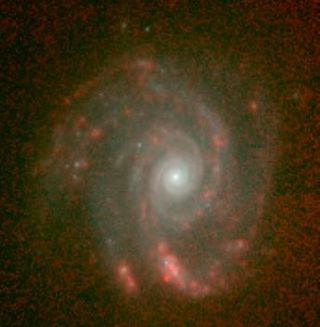
NGC 5653 is an unbarred spiral galaxy in the constellation Boötes. It was discovered on March 13, 1785 by John Herschel and subsequently placed in the New General Catalogue.

NGC 2363 is a star-forming region in the Magellanic galaxy NGC 2366 which is located in the constellation Camelopardalis. It contains NGC 2363-V1, a luminous blue variable star which is 6,300,000 times more luminous than the Sun and one of the most luminous stars known. It can be seen in this Hubble Space Telescope image as the bright isolated star in the dark void on the left of the nebula.

NGC 6027a is a spiral galaxy that is part of Seyfert's Sextet, a compact group of galaxies, which is located in the constellation Serpens. In optical wavelengths, it has a strong resemblance to Messier 104, the Sombrero Galaxy, with which it shares a near equivalent orientation to observers on Earth.
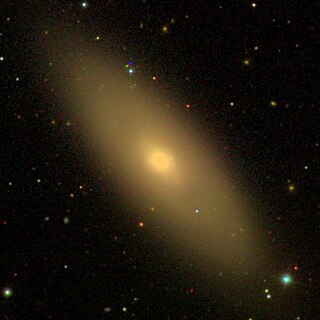
NGC 5838 is a lenticular galaxy in the constellation Virgo, discovered by William Herschel in 1786. It is a member of the Virgo III Groups, a series of galaxies and galaxy clusters strung out to the east of the Virgo Supercluster of galaxies.

NGC 265 is an open cluster of stars in the southern constellation of Tucana. It is located in the Small Magellanic Cloud, a nearby dwarf galaxy. The cluster was discovered by English astronomer John Herschel on April 11, 1834. J. L. E. Dreyer described it as, "faint, pretty small, round", and added it as the 265th entry in his New General Catalogue.

NGC 6027b is an interacting lenticular galaxy that is part of Seyfert's Sextet, a compact group of galaxies currently in the process of colliding and merging, which is located in the constellation Serpens.

NGC 6027c is a barred spiral galaxy that is part of Seyfert's Sextet, a compact group of galaxies, which is located in the constellation Serpens.

NGC 6027d is a barred spiral galaxy that is strictly a visual member of Seyfert's Sextet, a compact group of galaxies, which is located in the constellation Serpens. NGC 6027d is not interacting with the other galaxies in the cluster, but is in the background and just happens to be in the same line of sight. The galaxy is nearly 700 million light years away from the interacting group and is believed to be extremely large in size.

NGC 1427A is an irregular galaxy in the constellation Fornax. Its distance modulus has been estimated using the globular cluster luminosity function to be 31.01 ± 0.21 which is about 52 Mly. It is the brightest dwarf irregular member of the Fornax cluster and is in the foreground of the cluster's central galaxy NGC 1399.

Arp 273 is a pair of interacting galaxies, 300 million light years away in the constellation Andromeda. It was first described in the Atlas of Peculiar Galaxies, compiled by Halton Arp in 1966. The larger of the spiral galaxies, known as UGC 1810, is about five times more massive than the smaller galaxy. It has a disc that is tidally distorted into a rose-like shape by the gravitational pull of the companion galaxy below it, known as UGC 1813. The smaller galaxy shows distinct signs of active star formation at its nucleus, and "it is thought that the smaller galaxy has actually passed through the larger one."

NGC 1084 is an unbarred spiral galaxy in the constellation Eridanus. It is located at a distance of about 63 million light-years away from the Milky Way. The galaxy was discovered by William Herschel on 10 January 1785. It has multiple spiral arms, which are not well defined. It belongs in the same galaxy group with NGC 988, NGC 991, NGC 1022, NGC 1035, NGC 1042, NGC 1047, NGC 1052 and NGC 1110. This group is in turn associated with the Messier 77 group.



















